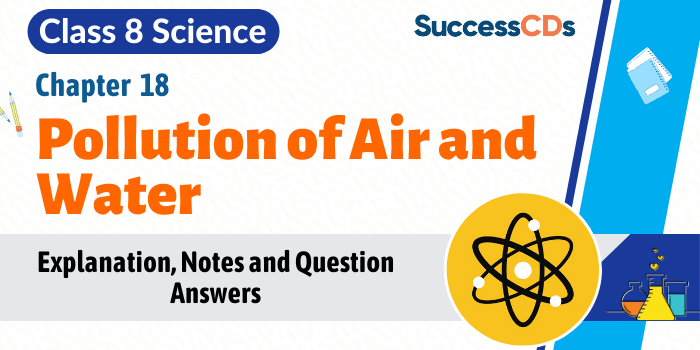Air and Water Pollution Class 8 Science Chapter 18- Explanation Notes, Question Answers
Pollution of Air and Water Class 8 Science Chapter 18 as per NCERT Book used in CBSE and other Schools. The lesson covers the complete explanation of class 8 Chapter 18 Pollution of Air and Water. Topics covered are Composition of Air, Air Pollution, SMOG, CFC- Chloro Fluoro Carbon, Carbon Monoxide, Unburned Particles, Case study – Taj Mahal, Acid Rain, Global warming, Green house effect, Steps to reduce air pollution, Water, Water pollutants, Harmful effects of Water pollution, Case Study – Ganga river, Ganga Action Plan, Potable water, Ways to make water fit for drinking, NCERT Book solutions. The lesson covers all important questions and NCERT solutions to book questions have also been provided for convenience of the students.
CBSE Class 8 Science Chapter 18
Pollution of Air and Water
- air
- acid rain
- Ganga Action Plan
- composition of air
- global warming
- potable water
- Air pollution
- green house effect
- Ways to make water fit for drinking
- SMOG
- steps to reduce air pollution
- NCERT book solutions
- CFC
- water
- carbon monoxide
- water pollutants
- unburned particles
- harmful effects of water pollution
- case study – Taj Mahal
- Case study – Ganga river
Pollution of Air and Water Chapter Introduction
As you know that earth is the only planet on which life is present but due to some of our activities we are creating pollution on earth. We are damaging our earth. So, in this chapter we will study that how air and water pollution is going to damage our earth and our environment.
Pollution of Air and Water Class 8 Video Explanation
Air
As we know that our earth is surrounded by an envelope of gases which is known as the atmosphere. This combination of various gases present in our atmosphere is known as air. By volume, about 78% of this mixture is nitrogen and about 21% is oxygen. Carbon dioxide, argon, methane, ozone and water vapor are also present in very small quantities. The major cause of pollution on earth is air pollution. So, what is pollution?
Well, presence of those substances in our atmosphere which are harmful for us is known as pollution.
Air Pollution
When air is contaminated by unwanted substances which have a harmful effect on both the living and the non-living, it is referred to as air pollution.
And what are the air pollutants?
The substances which contaminate the air are called air pollutants. Sometimes, such substances may come from natural sources like smoke and dust arising from forest fires or volcanic eruptions.
Pollutants are also added to the atmosphere by certain human activities. The sources of air pollutants are factories, power plants, automobile exhausts and burning of firewood and dung cakes.
So, now we will discuss about the various types of causes of air pollution
A thick fog-like layer in the atmosphere, especially during winters. This is SMOG which is made up of smoke and fog.
Smoke may contain oxides of nitrogen which combine with other air pollutants and fog to form smog. The SMOG causes breathing difficulties such as asthma, cough and wheezing in children.
CFC- Chloro Fluoro Carbon
CFCs are used in refrigerators, air conditioners and aerosol sprays. The vapors go in the upper atmosphere and deplete ozone layer. CFCs damage the ozone layer of the atmosphere. Depletion of ozone layer causes skin disorders.
Carbon monoxide is produced from incomplete burning of fuels such as petrol and diesel. When there is lack of oxygen then it result into incomplete burning of fuel which results into production of carbon monoxide instead of carbon dioxide. It is a poisonous gas. It reduces the oxygen-carrying capacity of the blood this means that it is very harmful for the human beings. This can lead to death also.
Another factor is unburned particle.
Unburned Particles
Automobiles which burn diesel and petrol also produce tiny particles which remain suspended in air for long periods. These particles are also called SPM (Suspended Particulate Matter). They reduce visibility. When inhaled, they cause diseases for example bronchitis. Such particles are also produced during industrial processes like steel making and mining. Power plants give out tiny ash particles which also pollute the atmosphere and they are so harmful that if inhaled can cause various diseases.
So, now we know that there are various types of pollutants present in the environment and they are very harmful for us. Let’s study the case of Taj Mahal.
Case study – Taj Mahal
Taj Mahal is a very beautiful monument in our country. This monument is also corroding day by day. It is suffering with the monument cancer and the main reason behind this corrosion is air pollution. Not only this there are many other monuments which are a heritage property for India are getting spoilt because of air pollution.
So, let’s see how this happens?
You must have heard about acid rain? You do have read about the water cycle which results into rain. So, now we will study what acid rain is?
- It is the one of the major causes of monument cancer. The exhaust which is released from the vehicle contains nitrogen dioxide and sulphur dioxide. As these gases are lighter they rise up in the sky.
- When rain water mixes with pollutants present in air. It result forms nitric acid and sulphuric acid resulting into acid rain.
- So, now the rain water no longer remains a pure water it turns into acidic water.
So, what are the harmful effects of the acid rain?
Effects of acid rain
- It leads to monument cancer, as it combines with marble damaging the calcium carbonate and deteriorates it.
- It affects ph of soil and makes it unfit for growing plants and if there will be no plants it will lead to ecological imbalance.
- It affects aquatic life too. When acid rain occurs, it disturbs the ph balance of water bodies resulting into damage to the aquatic life.
There are many more disadvantages. Just like acid rain one more issue of concern is global warming. So, let’s see what is global warming.
 Global warming
Global warming
It is the increase in the concentration of certain gases like carbon dioxide, methane, etc in air due to which infra red rays get trapped in it and it leads to increase in overall temperature of earth.
- The rays that come from the Sun consist of visible light, infra red rays and ultra violet rays. Out of these, only infra red rays and visible light reaches earth’s surface. On reaching earth, the infra red rays are reflected back and a portion of it is absorbed by earth’s surface.
- The reflected ones when pass through earth’s atmosphere, get trapped inside the gas molecules. As we know, it leads to heating effect. Therefore, the overall temperature of earth’s surface rises.
One of the applications of global warming is green house effect
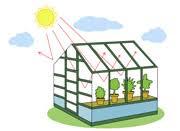 Green house effect
Green house effect
One of the reasons for global warming is green house effect.
In winters, it is advised to keep plants in green houses only. The roof allows infra red rays to enter but after reflection, they are not allowed to go back. As a result, they get trapped inside the green house and growth of plants is stimulated because optimum temperature is achieved inside the green house.
So, we can take certain steps to lower down the pollution level in our environment. But what are they?
Steps to reduce air pollution
- Cleaner fuels like CNG (Compressed Natural Gas). Its main component is methane.
- No crackers
- Alternative fuels instead of fossil fuels like solar energy, hydropower and wind energy
- plant trees as this will lead to healthy environment
- Do not burn dry leaves



Water

As you all know that water is very important because it is used for various purposes such as drinking, bathing, washing etc. But due to some of our activities water is also getting polluted. So, let’s see what is water pollution?
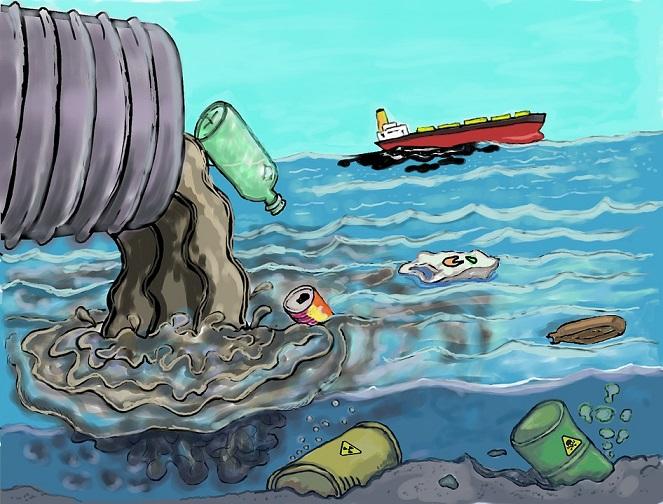 Water pollutants
Water pollutants
Whenever harmful substances such as sewage, toxic chemicals, silt, etc., get mixed with water, the water becomes polluted. The substances that pollute water are called water pollutants.
As shown in the image the waste bottles, wrappers which are thrown into the water causes water pollution due to this the water becomes unfit for drinking. Now we will study the effects of water pollution.
Harmful effects of Water pollution
- It affects the aquatic life
- It leads to eutrophication. When there is excess discharge of chemical into the water, this result into excess growth of algae. With the growth of more and more algae a new problem will arise that is the oxygen in the water level will reduce result into death of aquatic animals.
- It also spread lot of water borne diseases.
Now we will take up with a case study of Ganga River
Case Study – Ganga river
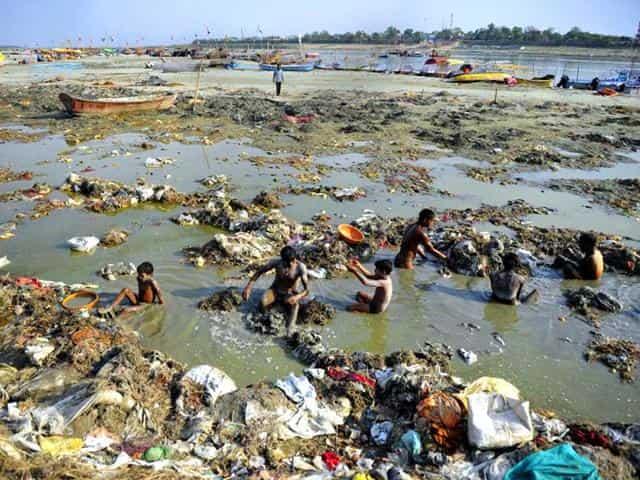
A serious problem which is faced by this holy river is that it has become a much polluted river.
World Wide Fund for Nature (WWF)’s study found that Ganga is one of the ten most endangered rivers in the world. The towns and cities, through which the river flows, throw large quantities of garbage, untreated sewage, dead bodies, and many other harmful things, directly into the river. All this is leading towards the pollution in the river Ganga.
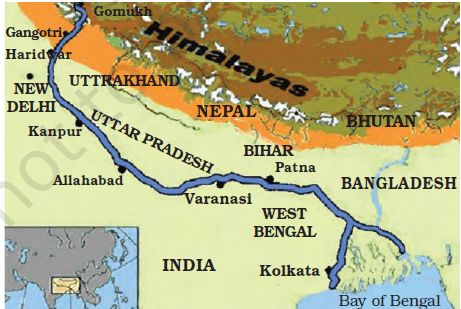
To control pollution level in the Ganga, A programme was initiated known as the Ganga Action Plan
Ganga Action Plan
Ganga Action Plan is a massive multi crore project implemented in 1985 which has undertaken to make the river Ganga pollution free. As you can see in the image shown below people are voluntarily contributing to clean the river Ganga. They are clearing the garbage from the river.
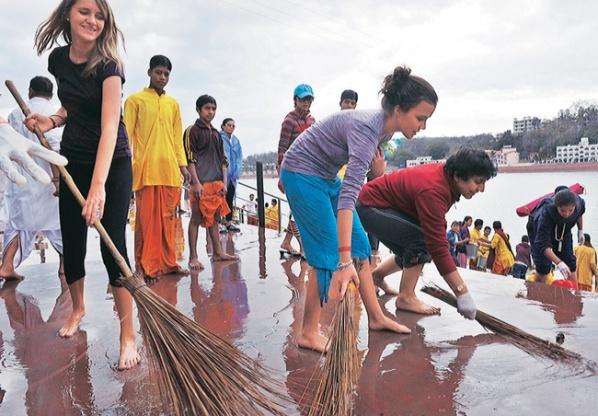
As it came in to notice that due to continuous dumping of waste in to Ganga, the bacteria coli form number has increased. During the tests it was found that the number of coli form has increased a lot showing the high pollution level of the river. This bacterium is otherwise found in human intestine. This has led to pollution in Ganga as people use Ganga River’s water for bathing, washing clothes and many other activities that affects the ph of water and makes it contaminated.
So, due to this the Ganga action plan was launched in the year 1985 but what was the aim of this plan?
Aim to reduce pollution levels in river Ganga. So, the main aim was to reduce the pollution level of Ganga to make it a clean river. As we know that the increasing population and industrialization have already damaged this mighty river beyond repair. So, the Ganga action plan was not as successful as it was thought.
Now, the Government of India has launched a new initiative known as National Mission for Clean Ganga (NMCG) in 2016.
Till now we have read that Ganga has become a polluted river and as we know that the increasing population is also one of the reason behind the polluting of the river. So, now we will study about the most populated city of U.P which is also contributing in the pollution of the river Ganga.
The Ganga at Kanpur in Uttar Pradesh (U.P.)
Kanpur is one of the most populated towns in U.P. People can be seen bathing, washing clothes and defecating in the river. They also throw garbage, flowers, idols of gods and goddesses and non biodegradable polythene bags into the river. So, when river flows from this area, it has been noticed that it is the place where the river is affected so badly because people here are continuously dumping various things into the river which lead to the pollution in the river. Here the amount of water is comparatively small and the flow of the river is very slow.
Kanpur has more than 5000 industries. These include fertilizer, detergent, leather and paint industries. These industrial units discharge toxic chemical wastes into the river. Many industries discharge harmful chemicals into rivers and streams, causing the pollution of water such as eutrophication which we have already discussed. This also affects the purity of water making it unfit for drinking purpose. So, therefore it becomes important for all of us to take a responsibility to keep Ganga clean. Examples are oil refineries, paper factories, textile and sugar mills and chemical factories.
Q. How do industries cause pollution in the river?
Ans. Many industries discharge harmful chemicals into rivers and streams causing the pollution of water. Examples are oil refineries, paper factories, textile and sugar mills and chemical factories. These industries cause chemical contamination of water. The chemicals released include arsenic, lead and fluorides which lead to toxicity in plants and animals. Industries are supposed to treat the waste produced before discharging it into waters, but quite often the rules are not followed. The soil is also affected by impure water, causing changes in acidity, growth of worms, etc.
Sometimes untreated sewage is thrown directly into rivers. It contains food wastes, detergents, microorganisms, etc. Water contaminated with sewage may contain bacteria, viruses, fungi and parasites which cause diseases like cholera, typhoid and jaundice. So, it is affecting human life also. The bacteria present in the faeces of mammals are indicators of the quality of water. If water has these bacteria, it means that it has been contaminated by faecal matter. If such water is used by us, it can cause various infections.
Potable water
Water which is suitable for drinking is called potable water. The water, which is fit for drinking because it is clean and transparent. The Ph level of this water is 7. There are no microorganism present in this water.
 So, how can we make our water safe for drinking purpose? Let’s have a look at this.
So, how can we make our water safe for drinking purpose? Let’s have a look at this.
Ways to make water fit for drinking
- Filtration: You have already seen how water is filtered. This is a physical method of removing impurities. A popular household filter is a candle type filter. There is reverse osmosis system present in such filters which make water pure.
- Boiling: Many households use boiling as a method for obtaining safe drinking water. Boiling kills the germs present in the water.
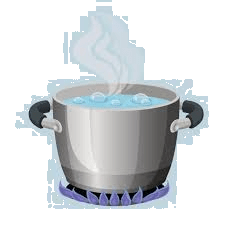
- Chlorination: Chlorination is a commonly used chemical method for purifying water. It is done by adding chlorine tablets or bleaching powder to the water. We must be cautious. We should not use more chlorine tablets than specified.
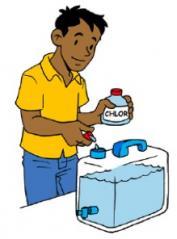
Laws for industrial units should be strictly implemented so that polluted water is not disposed off directly into rivers and lakes. Water treatment plants should be installed in all industrial areas. Reusing water used for washing and for other household tasks. Water used for washing vegetables may be used to water plants in the garden.
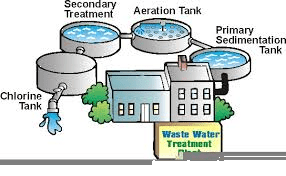
NCERT Book solutions
Question/Answers:
Q1- State the different ways in which water is contaminated?
A1- Following are the different ways which contaminate water:
Sewage waste: The sewage waste such as laundry waste or the toilet waste causes pollution in water.
Industrial waste: the chemicals released by the various industries onto the river system are also one of the causes of pollution in water.
Pesticides: The use of pesticide and fertilizers by the farmers in their fields are carried away by the rains into the rivers resulting into the contamination of water.
Q2- At an individual level, how can you help reduce air pollution?
A2- The following are the steps taken for reduction of air pollution:
- We should use public transport as much as possible.
- We should properly dispose the garbage and not burn it.
- The amount of emissions from household chimneys and vehicles should be controlled.
- We should replace our vehicle fuel, diesel and petrol by LPG and CNG.
- Dry leaves should not be burned.
- Plant more and more trees.
Q3- Clear, transparent water is always fit for drinking. Comment?
A3- No, we cannot support the above statement because it is not always necessary that the clear, transparent water is fit for drinking. It may have some kind of impurities present in it in the form of micro organism. Therefore it is suggested to first purify it by using filters or by boiling it and then use it.
Q4- You are a member of the municipal body of your town. Make a list of measures that would help your town to ensure the supply of clean water to all its residents?
A4- Following steps should be taken:
- Cleaning the supply pipes regularly
- Using Chlorine to purify water.
- Maintaining the source of water to keep it clean and pollution-free.
Q5- Explain the differences between pure air and polluted air?
A5- The composition of pure air is 78% nitrogen, 21% oxygen and 0.03% carbon dioxide. Apart from this there are some more gases present such as ozone, argon, methane etc. if this balance or composition gets changed due to the human activities it becomes a polluted air because the gases such as sulphur dioxide and carbon monoxide get added into this leading to the pollution of air.
Q6- Explain circumstances leading to acid rain. How does acid rain affect us?
A6- Explain circumstances leading to acid rain. How does acid rain affect us? Sulphur dioxide and nitrogen dioxide are the type of pollutants, which is released into the atmosphere by the burning of fossil fuels like diesel and coal. These pollutants react with the water vapours present in the atmosphere to form nitric acid and sulphuric acid respectively. By precipitation, these acid come down and forms the acid rain. Its harmful effects are as follows:
- It can lead to building cancer. This means it is harmful for those buildings made up of marble as it was discussed in the case study of the Taj mahal.
- It also destroys the crops in the field
Q7- which is not a greenhouse gas?
a) Sulphur dioxide
b) Carbon dioxide
c) Nitrogen
d) Methane
A6- Nitrogen
Q8- Describe the ‘Green House Effect’ in your own words?
A8- The overall increase in the temperature of the Earth is known as the Greenhouse effect. When solar radiation reaches the Earth, some radiations are absorbed by the Earth and then released back to the atmosphere. Greenhouse gases present into the atmosphere trap these radiations and do not allow the heat to leave. This helps our planet in keeping itself warm and thus helps in human survival. However, an indiscriminate increase for gases can lead to excessive increase in the Earth’s temperature leading to global warming.
Q9- Prepare a brief speech on global warming. You have to deliver the speech in your class?
A9- Global warming is a situation when there is increase in the average temperature of earth. It occurs when there is increased concentration of greenhouse gases. These are methane, carbon dioxide and water vapor. These gases do not allow the gases to release back by the earth which result into trapping of the gases which in return causes increase in the temperature of earth’s surface.
Q10- Describe the threat to the beauty of the Taj Mahal?
A10- Acid rain is the major threat to the beauty of the Taj Mahal. Taj Mahal as we all know is made up of marble. When acid rain falls on it, this result into a reaction between the acidic water and marble resulting into the deterioration of the building. This phenomenon is also known as building cancer.
Q11- Why does the increased level of nutrients in the water affect the survival of aquatic organisms?
A11- An increase in the level of nutrients in water body leads to an increase in the growth of algae in the water. When these algae die, they serve as food for de-composers. A lot of oxygen is utilized in this process, consequently leading to a decrease in the level of oxygen dissolved in the water body. This process is known as eutrophication. This in turn causes fishes and aquatic organisms to die.
